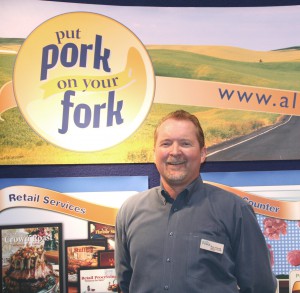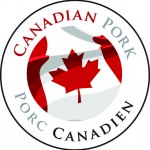Focus on maximizing pig value, US economist advises
Posted in: Economics by admin on July 12, 2011 | No Comments
 Producers should focus on maximizing the value of the pigs that they sell in order to improve margins, rather than trying to cut costs without understanding the potential consequences, says Dr. Dennis DiPietre, an economist from Missouri. He was speaking at a series of meetings held across Canada, which were organized by Elanco Animal Health. “When people are in survival mode, they make decisions that might look as if they are going to result in a net benefit, but very often they don’t,” he says. “During the 1998-9 pig crisis, one large US production company took all the cell phones away from their staff. What might be the cost of missing just one vital communication?”
Producers should focus on maximizing the value of the pigs that they sell in order to improve margins, rather than trying to cut costs without understanding the potential consequences, says Dr. Dennis DiPietre, an economist from Missouri. He was speaking at a series of meetings held across Canada, which were organized by Elanco Animal Health. “When people are in survival mode, they make decisions that might look as if they are going to result in a net benefit, but very often they don’t,” he says. “During the 1998-9 pig crisis, one large US production company took all the cell phones away from their staff. What might be the cost of missing just one vital communication?”
DiPietre says that herd recording programs focus on sub-systems of production and fail to tie the whole production process together. “That means we lose the idea that the value of the end product is the key thing,” he explains. “For example, weaning age and weight affect growth in the nursery and through to market, but this never used to be considered by the sow farms. Bonus schemes focussed on breeding parameters, not what happened in the nursery. Now the impact is appreciated, producers are investing in more farrowing crates in order to increase weaning age.”
Producers can increase their income by maximizing the number of “Full Value Pigs” that they sell, says DiPietre. He defines these as high health, quality pigs that reach an optimum weight in the desired time to achieve maximum market price. In order to increase the number of Full Value Pigs, it is necessary to know the growth rate of pigs close to market weight and their feed intake. It is also essential to know the relationship between carcass weight and lean percentage in the population of pigs because, as pigs get heavier, their carcass lean reduces, which may have an impact on index and value. The price received for the various weight classes of pig, as defined by the grading grid, must also be known. From all this data, the weight at which net revenue is highest can be calculated and compared with the actual weight of pigs shipped.
“The optimum weight is dependent on the grading grid and also the cost of feed,” DiPietre notes. “The profit-maximizing weight under November 2006 assumptions for the US was 135kg, but today it is only 127kg.”
The number of Full Value Pigs can be increased by moving the average weight of pigs shipped closer to the optimum and by reducing the degree of weight variation. “The greater the variation in weight of pigs shipped, the lower the optimum weight at slaughter,” explains DiPietre. “Therefore, if you can reduce variation, average market weight can be higher, giving more kilos sold and increasing value.” This will also increase the average price received per kilo, he says, because the biggest price discounts are in the extremes of the weight distribution. A tighter weight range will also result in improved feed efficiency and lower feed costs, DiPietre notes.
In addition to improving selection of pigs for market to optimize weight, producers should look for the reasons for variation within their pigs, he believes. This could be related to health challenges, variation in weaning age, variation in throughput and stocking density or variation in feeds. Better management to reduce such variation, such as more timely treatment of health problems, will increase the percentage of Full Value Pigs, DiPietre says. He advises producers to focus on the bottom 30% of pigs because this will have the most impact.
Maximizing the value of the end product will become essential in the new high-cost feed environment, stresses DiPietre. “A doubling of feed prices means that producers will have to deliver more value than in the past,” he says. “This is what will separate those people that are going to be successful in the future and those that aren’t.”
$1.4 million to promote Canadian Pork as imports soar
Posted in: Economics, Meat Quality by admin on | No Comments

 Soaring pork imports – estimated to be 25% higher in 2008 – have heightened the need for more consumer awareness of the origin of the pork that they purchase. Pork Marketing Canada (PMC) recently announced that it had obtained funding of almost $1.4 million for its Canadian Pork initiative, which is aimed at increasing sales of Canadian pork. A new “Canadian Pork” label will be used to identify the product in participating grocery stores.
Soaring pork imports – estimated to be 25% higher in 2008 – have heightened the need for more consumer awareness of the origin of the pork that they purchase. Pork Marketing Canada (PMC) recently announced that it had obtained funding of almost $1.4 million for its Canadian Pork initiative, which is aimed at increasing sales of Canadian pork. A new “Canadian Pork” label will be used to identify the product in participating grocery stores.
“Shoppers now have the choice to choose Canadian,” says Roy Kruse, Manager of Pork Marketing Canada. “Until this label, consumers didn’t know whether or not the pork they found at their local meat counter was imported or Canadian. The new label gives them the opportunity to identify and choose Canadian pork over imports.”
The PMC initiative is supported by studies that show Canadian consumers will choose Canadian products over imports if given the choice. “Canadians want high-quality foods that are safe and produced under environmentally sustainable practices”, notes Kruse. “More and more, they want to buy Canadian.” A study by the Canadian Federation of Agriculture found that 90% of Canadian consumers felt Canadian-grown product should be easily identifiable in stores. Further, 95% of consumers would prefer to buy Canadian-grown product that is competitively priced.
These findings are consistent with an Agriculture and Agri-Food Canada study that found the quality of food produced in Canada is viewed as better than food produced in other countries. Canadian consumers continue to believe that Canada has better production practices and standards and more rules and regulations than other countries. “Not surprisingly, the demand for local food continues to rise,” explains Kruse. “With heightened concerns for the environment and an increasing focus on food safety, people are more interested than ever in the food on their plate.”
In western Canada, participating stores initially include Save On Foods, Overwaitee and Safeway. “It is hoped more retailers will come on board as time goes on,” says Kruse. Also, some Maple Leaf Foods fresh pork products will be labelled Canadian in retail stores where Maple Leaf Foods fresh pork products are carried. Labels will be on fresh pork products from early April onwards. “The assumption is that consumers will choose Canadian product over other options if pork is clearly labelled,” Kruse believes.
The labelling initiative will be supported by an ongoing media campaign to improve consumer awareness. “This campaign is about people as much as it is about pork,” says Kruse. “The campaign will focus on the positive aspects of Canadian pork producers, their high quality product and their contribution to Canadian society and its economy.”
Pork Marketing Canada expects the “Canadian Pork” label campaign to help boost sales of Canadian pork and help to mitigate some of the financial issues faced by the industry.
Pork Marketing Canada is a national marketing initiative of provincial pork organizations across Canada. The purpose of this alliance is to increase the consumption of Canadian pork by partnering with packers, processors, retailers and food service distributors and operators. Pork Marketing Canada offers expertise, information and funding towards programs that promote pork, and further develop sales. For more information, visit www.putporkonyourfork.com
Dissecting the competitiveness of the Canadian hog sector: Past and future, perception and reality
Posted in: Economics, Pork Insight Articles by admin on May 8, 2011 | No Comments
The abstract for an economic analysis of the decline in net producer revenue. The contributions of exchange rates and feed costs were 23% each, the recession was 18%, and mandatory country of origin labeling was 36%. Mandatory country of origin labeling costs are problematic since they cannot be adjusted, and contribute significantly to net revenue decline.
Packer’s Perspective of Heavier Carcass Weights
Posted in: Economics, Pork Insight Articles by admin on May 7, 2011 | No Comments
Hog market weights have been increasing, and the trend is expected to continue. The packer’s cost are a combination of fixed and variable costs, and the per hog cost decreases with increasing volume. The fixed costs for a packer don’t change with an increase in volume, so higher weights mean an increase in profit. The profit increase is greater than the cost increase, so net profit increases with higher weights.
Heavier Carcass Weights – Producer Economics
Posted in: Economics, Pork Insight Articles by admin on | No Comments
There has been a trend of increasing market weight for decades, and it is expected to continue due to supplier demand and producer benefit. The benefit to the producer is that as weight increases the cost per additional kg decreases; however, space may be a limiting factor. Building new facilities, or additions to existing facilities is an expensive option to provide space. Two more cost efficient ways to provide sufficient space would be to reduce breeding, or sell excess weanlings. Even though fewer market pigs will be produced, the net profit per kg will increase.
Global Price and Production Forecast
Posted in: Economics by admin on April 29, 2011 | No Comments
The main factors for pork production profits are the exchange rates, pork trade, and economy strength; and the costs mostly depend on biofuel demand and crop yields. Corn prices used to be driven primarily by weather and crop yields, and while that is still a factor, the rise of using corn for ethanol has doubled corn prices. This has led to a 50% increase in the cost of hog production. Since 2007, the Canadian dollar has been strong, but this negatively affects pork export into the USA. As well, the pork demand in the USA has been lowered due to a poor economy, but rising beef prices may increase pork consumption. The hog cycle is the supply and demand for pork, so high production will lower prices and vice versa. Compared to 30 years ago, the cycle has a much smaller amplitude – mainly because modern facilities are not equip to manage rapidly fluctuating production numbers. Plain concludes by predicting a decrease for Canadian pork export for 2011, but similar slaughter numbers to 2010
Financing Agriculture in the Future
Posted in: Economics by admin on | No Comments
Presentation by AgStar Financial Services at the Banff Pork Seminar, 2011. Stresses the importance of risk management in a market where the prices of feed and the profits for pork are volatile. Also, mentions producers need to have detailed knowledge of their financial situation – including cost of production and monthly financial performance – and the need to have a business plan with the goal of stabilizing finances.
The Future of Animal Feeding: Towards Sustainable Precision Livestock Farming
Posted in: Economics, Environment, Nutrition, Pork Insight Articles by admin on | No Comments
With the cost of feed accounting for 60% of production costs it is important to improve productivity and efficiency. However, the requirements of the customer, consumer and society need to be taken into account. This brings the idea of focusing on sustainable precision livestock farming as a future goal. The consumer demand in developed countries has become concerned with animal welfare, environmental impact, quality, safety, and the type of production system. With a growing population there will be an increased demand for food, but while developing countries will have a rapidly increasing demand for meat products developed countries will have, a much slower, or even stagnant, growth. Meanwhile, costs for feed could increase as supply becomes more limited. There is potential for improving productivity and efficiency while meeting public demands through newly developed and promising technology. Genomics have improved crops through the use of genetically modified crops, and there is still further developments possible. As well, genetic markers can be developed to allow testing for traits like meat quality and disease resistance. Nutrigenomics will be able to help determine the precise nutrient requirements in certain conditions. Microsystem and nanotechnology have the potential to be useful for sampling for micronutrients, contaminants and toxin metabolites inside and outside of an animal. Information and communication technology will allow for developments like automated feeding systems, and allow for ease and accuracy in sharing data. Near-Infrared Spectroscopy can quickly and easily sample feed for macro nutrients, and has the potential to do the same for micronutrients and contaminants. Overall, using current technological advances, and continuing to research and develop them will allow improved precision while meeting societal needs for sustainable farming.
An Overview of the Canadian Swine-Pork Sector
Posted in: Economics, Pork Insight Articles, Press Releases by admin on April 7, 2011 | No Comments
The demographics of the Canadian swine industry is such that there is concentration in the hog production with regard to size; this is most evident in Quebec where the data are most fragmented, but this appears to be broadly the case- a small number of large farms produce the bulk of market hogs and hold the bulk of the sows. Secondly, the hog production segment has declined across the country. This is particularly the case in western Canada and Ontario, but also in Quebec. Finally, the pork packing segment is relatively concentrated, with the hog production segment increasingly sized to the packing segment. The potential implication of this is to allow, prospectively, packing system alignment back to the farm level.
Branding Canadian Pork – Defining Consumer Wants
Posted in: Economics, Meat Quality, Pork Insight Articles by admin on March 30, 2011 | No Comments
Brand identity can help garner customer loyalty, but also has an economic impact through increased revenue and market shares, and decreased price sensitivity. A clear image around a product helps to create a brand. Canadian Pork can become a brand for global and domestic consumers. The chicken and beef industries have managed to create brands of their own: chicken through superior air-chilled products, and beef through premium graded beef. Pork can become branded through a grading system, and features like colour and marbling. Branding marbling as a better tasting product with naturally occurring fat can make it a premium product, but having premium lean products as well could be achieved through a two-tier classification system.









